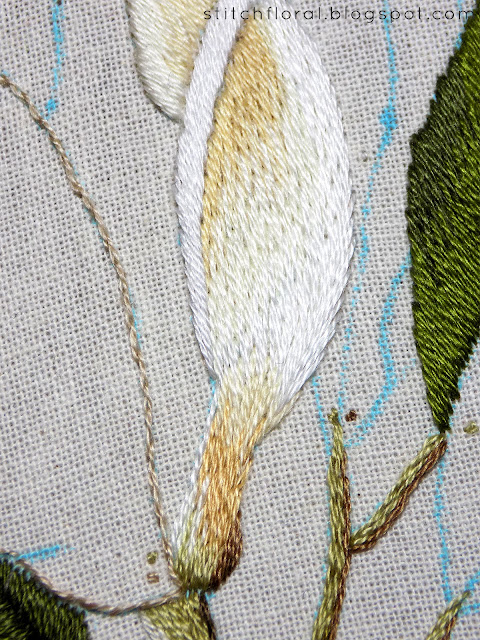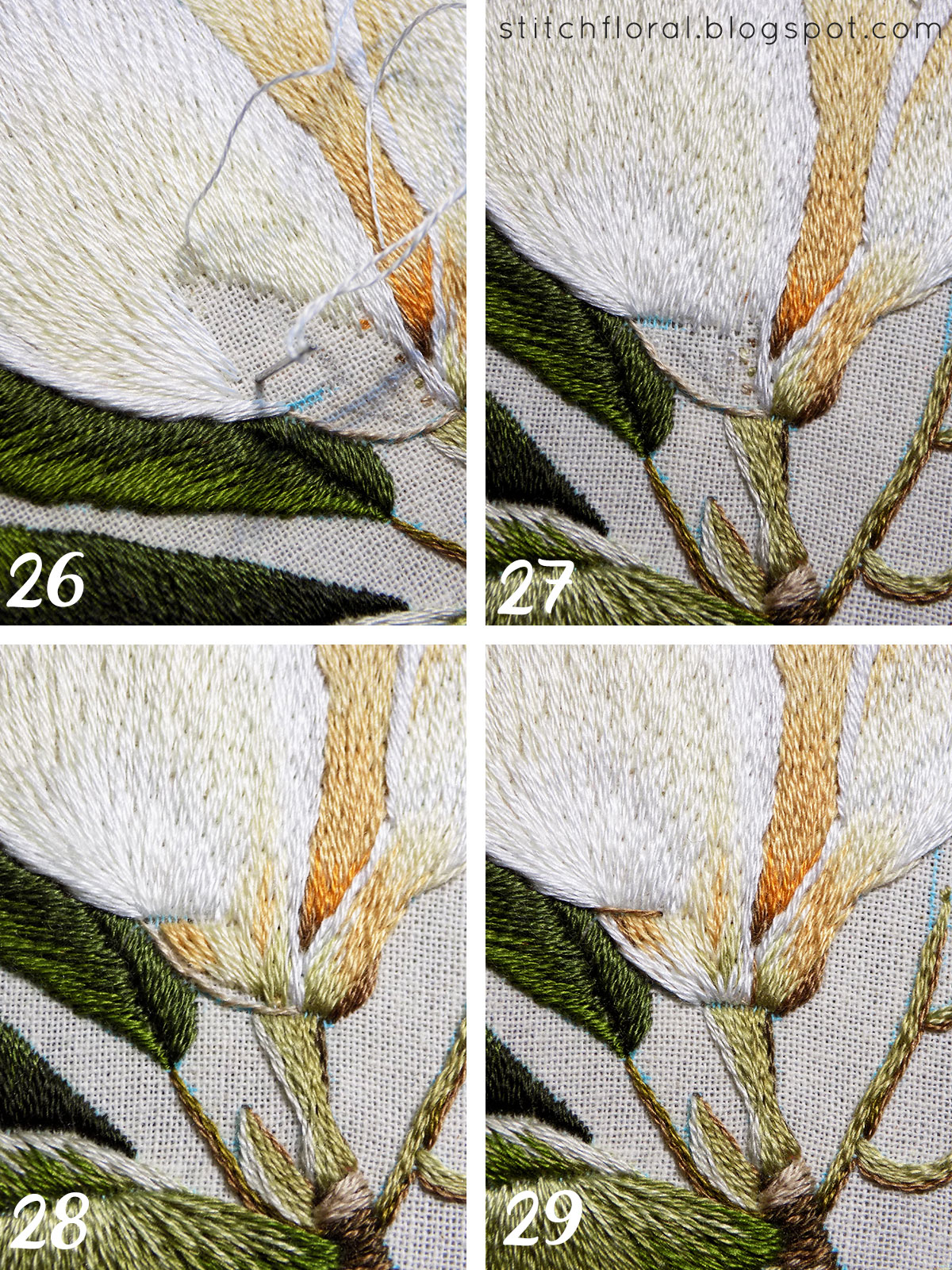Part 4 of the Stitch Along is here! One of the most exciting in my opinion, because finally we are working the flower blossom. Originally, Trish mentions working the red leaves after the green ones, but I thought that we need a bit of variety after working a total of 8 leaves.
Speaking of Trish, she has a message for you!
“I have been peeking and you are all doing an amazing job! For those of you who are starting out there is nothing to be nervous about - just relax and enjoy your stitching it will show in your finished piece. Also remember everyone is individual so everyone’s work will look different- don’t compare with your neighbor because it will never look the same”.
These words are very meaningful and I hope everyone will hear. It is perfectly understandable to be nervous or anxious when you start, but don't let it stop you from creating something beautiful. Make the stitches, work at your own pace, do your thing and look at others only as a source of inspiration. You're doing a great job!
Here are the previous parts if you missed them:
Magnolia Stitch Along Part 1
Magnolia Stitch Along Part 2
Magnolia Stitch Along Part 3
Before we start
I have to warn you that today's post is very long and contains a lot of pictures. It might seem overwhelming but I just wanted to provide more details for the blossom because this part is central in the design and holds a lot of significance. So let's do our best!
Today we need these thread: U, W, X, Y, Z, ZZ, R and also J and B.
I'm using the colors according to what I see in the pictures in the book, but if you think there are different colors used in certain places, feel free to adjust it to your vision.
I will end the foreword here to not make the post even longer, but if you have any questions or comments – share your thoughts under the post in the comments section!
Magnolia Blossom
So, for starters, I noticed that the pattern from the book is a bit different from the original work. If you are good at arts and drawing, can improvise and know how the colors would work with the changes in the pattern, then you can leave it as it is.
I, on the other hand, am really bad with this stuff, so I just fixed it to fit the original work in the pictures. The black lines in the image above is what I added and the white lines is where I “erased” a line. Erased in quotation marks because I didn't actually erase anything, I just smudged it with a pencil, haha.
You do you. I believe there are many artists with a good sense of color behavior among our participants, so maybe you crack the pattern and bring forward a new look for this blossom. That would be thrilling to see!
After you outline the figure with split stitch, start filling in the upper petals with satin stitch. By the way, if you find a black arrow in the image above you can see that I didn't work an outline for it.
1 -2. Working satin stitch in the following order from left to right: U – X – Z – J. As you work every segment of color, add few long and short stitches of the new color to the previous segment, it makes the gradation of color smoother.
3-4. Here we are working long and short stitch with X thread on top and Y thread in the bottom.
5. This part is worked in satin stitch using thread U. It is likely, that the lower you go, the longer your stitches will become, so try to keep them slanted at the same angle to keep the look consistent.
6. Now we work the right petal in long and short stitch. Start with color Z.
7. Add a bit of Y color to make the transition smoother.
8. Now add a row of X thread.
9. And work long and short stitch in W thread in the rest of the wide part of the petal.
10. As the petal narrows down, add these colors: Y, ZZ, J in the right lower corner and the green B in the left lower corner. Also add the U border on the left, continuing the folded part of the petal which we worked in step 5. I added a couple of stitches in U as well, just for the sake of it.
Here's how the finished petal looks like.
11. Next, we work satin stitch in the upper part of the flower again. The white one is worked in W. For the others, I worked the bases in threads Y and Z.
12. Then added long and short stitches of ZZ in the bottom.
13. Then added J color in the same way.
14. There are also some highlights at the top of the broadest one, I think, so I added some stitches in W thread over there.
I don't know, I tried to replicate as close to the original as I could, haha. Looks fine, imo. So let's go further.
15. Worked this little part as well. Using thread Z and J here. Also, you might notice I already prepared to work the central part and have marked the direction of stitches and areas of colors.
16. But before that, there are few more places on the left side we can fill using thread W and X.
17. Okay, now is the time! We start with thread U, making long and shorts stitches, possible two rows until we fill enough space.
18-19-20. Then we switch the thread to other colors in the following order: X, Y, Z, ZZ, R and J in the very bottom. The Z and ZZ parts were longer than the previous ones because that's how I saw it. Work it steadily and use guiding stitches if you need.
21. Before we start with the last petal, I decided to do the outlining – take 2 strands of U thread and work split stitch over the edges.
22-23. Working the top of the final petal in U thread. We are covering a long stripe with a peculiar shape, so using guiding stitches will make it easier to keep the direction of stitches consistent.
24-25. I switched to W thread first, making it the second row of long and short stitching. And then it was the turn of X color, which occupies quite a lot of space here. Work it in long and short stitches, using guiding stitches, step by step. I believe marking the direction of the stitches first would be a good idea, I'm using a simple pencil for that.
26-27. Then we turn back to W thread, working till the line.
28-29 There is a splatter of various colors in the lowest part, I hope you will be able to decipher their placement and I will just mention the threads: Y, ZZ, U and B. In the end, the line is worked in thread J.
That's all!
Phew. Feeling like you've just run a marathon?
Yup, I know it's tough. You can do it, though! I believe in you!
Honestly speaking, it was a bit hard to provide eloquently written comments for this part, but I hope the pictures will speak more clearly and loudly and you will still get a good understanding.
If you still have any questions, feel free to leave them below in the comments section or write me a note in the contact form :)




























I accidently came across your blog as prepearing myself to start my very first embroidery. How wonderful are you for sharing your knowledge!You're so lovely! Thank you so much!
ReplyDeleteI'm happy if it helps! :)
ReplyDelete